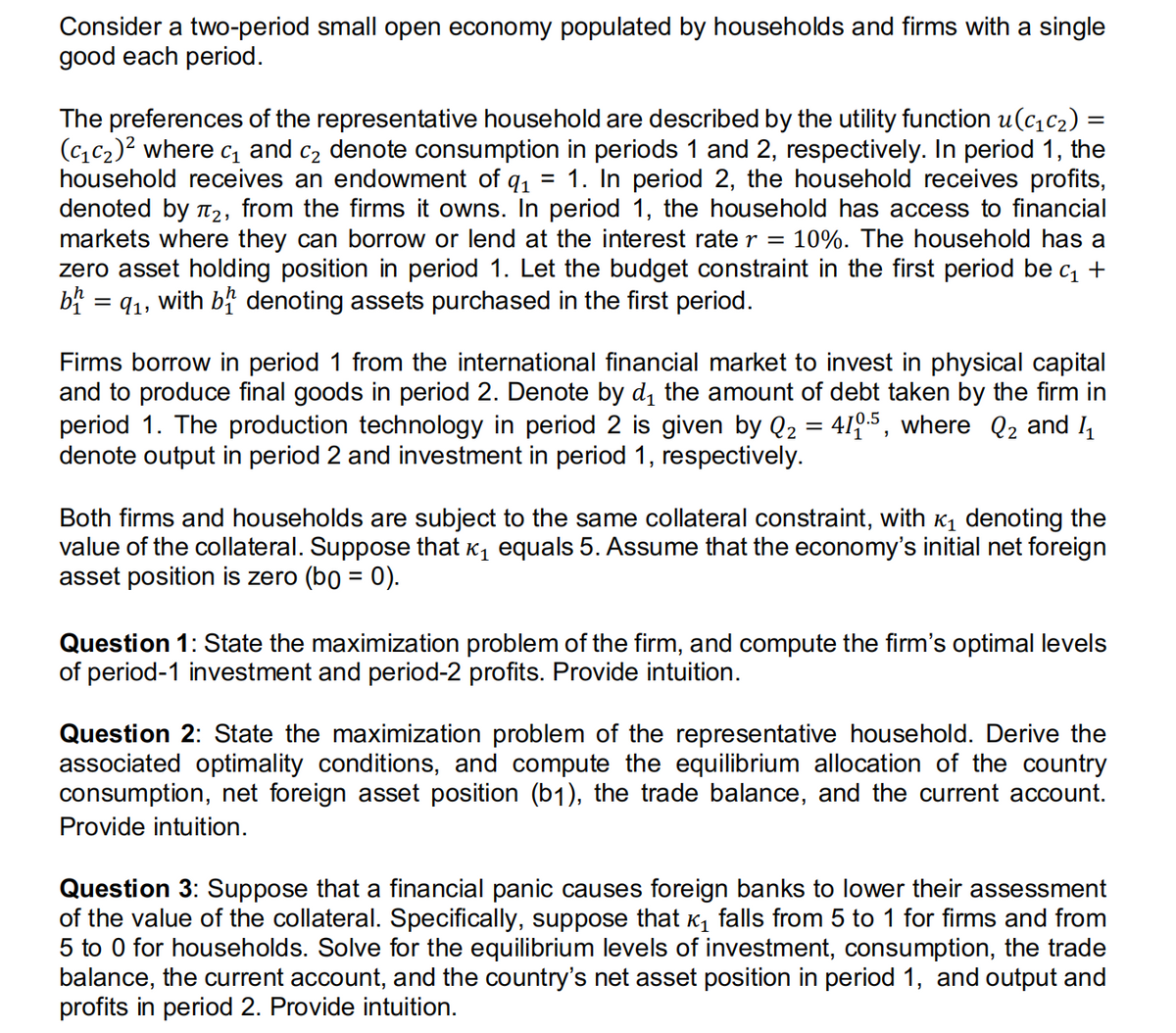Question 3: Suppose that a financial panic causes foreign banks to lower their assessment of the value of the collateral. Specifically, suppose that ₁ falls from 5 to 1 for firms and from 5 to 0 for households. Solve for the equilibrium levels of investment, consumption, the trade balance, the current account, and the country's net asset position in period 1, and output and profits in period 2. Provide intuition.
Question 3: Suppose that a financial panic causes foreign banks to lower their assessment of the value of the collateral. Specifically, suppose that ₁ falls from 5 to 1 for firms and from 5 to 0 for households. Solve for the equilibrium levels of investment, consumption, the trade balance, the current account, and the country's net asset position in period 1, and output and profits in period 2. Provide intuition.
Chapter1: Making Economics Decisions
Section: Chapter Questions
Problem 1QTC
Related questions
Question
Please solve for the question (3)
I will be very very appreicate!!

Transcribed Image Text:Consider a two-period small open economy populated by households and firms with a single
good each period.
The preferences of the representative household are described by the utility function u(c₁c₂) =
(C₁C₂)² where c₁ and c₂ denote consumption in periods 1 and 2, respectively. In period 1, the
household receives an endowment of q₁ 1. In period 2, the household receives profits,
denoted by T₂, from the firms it owns. In period 1, the household has access to financial
markets where they can borrow or lend at the interest rate r = 10%. The household has a
zero asset holding position in period 1. Let the budget constraint in the first period be c₁ +
b = 9₁, with b denoting assets purchased in the first period.
Firms borrow in period 1 from the international financial market to invest in physical capital
and to produce final goods in period 2. Denote by d₁ the amount of debt taken by the firm in
period 1. The production technology in period 2 is given by Q₂ = 410.5, where Q₂ and 1₁
denote output in period 2 and investment in period 1, respectively.
Both firms and households are subject to the same collateral constraint, with ₁ denoting the
value of the collateral. Suppose that ê₁ equals 5. Assume that the economy's initial net foreign
asset position is zero (bg = 0).
Question 1: State the maximization problem of the firm, and compute the firm's optimal levels
of period-1 investment and period-2 profits. Provide intuition.
Question 2: State the maximization problem of the representative household. Derive the
associated optimality conditions, and compute the equilibrium allocation of the country
consumption, net foreign asset position (b1), the trade balance, and the current account.
Provide intuition.
Question 3: Suppose that a financial panic causes foreign banks to lower their assessment
of the value of the collateral. Specifically, suppose that ₁ falls from 5 to 1 for firms and from
5 to 0 for households. Solve for the equilibrium levels of investment, consumption, the trade
balance, the current account, and the country's net asset position in period 1, and output and
profits in period 2. Provide intuition.
Expert Solution
This question has been solved!
Explore an expertly crafted, step-by-step solution for a thorough understanding of key concepts.
Step by step
Solved in 3 steps

Knowledge Booster
Learn more about
Need a deep-dive on the concept behind this application? Look no further. Learn more about this topic, economics and related others by exploring similar questions and additional content below.Recommended textbooks for you


Principles of Economics (12th Edition)
Economics
ISBN:
9780134078779
Author:
Karl E. Case, Ray C. Fair, Sharon E. Oster
Publisher:
PEARSON

Engineering Economy (17th Edition)
Economics
ISBN:
9780134870069
Author:
William G. Sullivan, Elin M. Wicks, C. Patrick Koelling
Publisher:
PEARSON


Principles of Economics (12th Edition)
Economics
ISBN:
9780134078779
Author:
Karl E. Case, Ray C. Fair, Sharon E. Oster
Publisher:
PEARSON

Engineering Economy (17th Edition)
Economics
ISBN:
9780134870069
Author:
William G. Sullivan, Elin M. Wicks, C. Patrick Koelling
Publisher:
PEARSON

Principles of Economics (MindTap Course List)
Economics
ISBN:
9781305585126
Author:
N. Gregory Mankiw
Publisher:
Cengage Learning

Managerial Economics: A Problem Solving Approach
Economics
ISBN:
9781337106665
Author:
Luke M. Froeb, Brian T. McCann, Michael R. Ward, Mike Shor
Publisher:
Cengage Learning

Managerial Economics & Business Strategy (Mcgraw-…
Economics
ISBN:
9781259290619
Author:
Michael Baye, Jeff Prince
Publisher:
McGraw-Hill Education